Michael F. Barrett
Dean of Mayo Men in New York
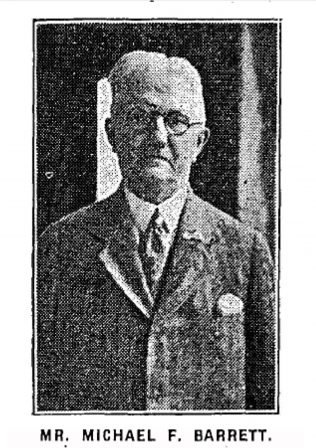
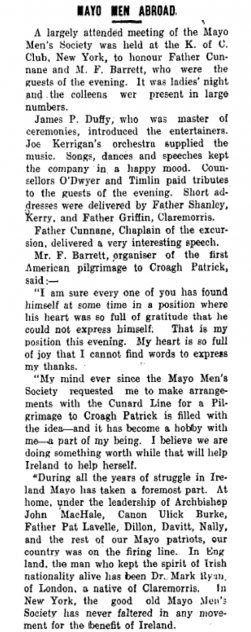
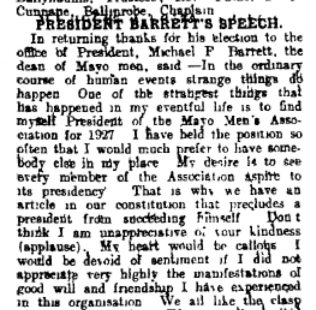
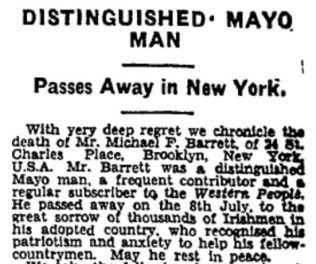

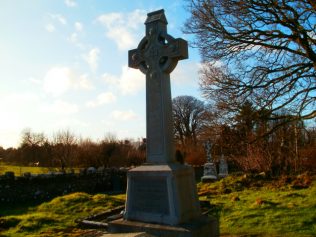
The silence was heavy in the meeting hall of the Mayo Men’s Association of New York on that dismal day in 1906, where the members had gathered after hearing that Michael Davitt had died. Davitt had visited the city frequently since the days of the beginning of the Land League. He was a guiding light to the Mayo men and they credited his sound advice for their accomplishments. It was with great sadness that they sent a cable to John Dillon in Ireland expressing their sorrow, and their sympathy to Mrs Davitt. Michael F Barrett, the Association’s President wrote that the message was simple, ‘but oh! what a depth of sorrow followed it across the Atlantic.’ (Barrett, Michael. “Mayomen and Davitt’s Death.” Connaught Telegraph, June 23, 1906).
Michael Davitt, regarded by many as a true Irish patriot, was a fellow Mayo man whom Barrett considered a friend. Michael Barrett also was well known in the New York Irish circles as a patriot. He was an active member of several Irish associations, including the Irish Club and the United Irish Counties where he had served as President and Vice President, but it was the Mayo Men’s Association that he gave his heart to for half a century.
The Mayo Men’s Association of New York
Organisations for Irish immigrants, often based on their county of origin, were formed in their adopted countries. They provided support for the new arrivals and helped them establish themselves while sustaining their strong sense of Irish identity. Besides the fellowship offered for members, with activities such as picnics, dances and sporting events, many of these societies raised money for people and causes back home. After the failure of the potato crop in Ireland in 1890, the Mayo Men’s Association donated all of the proceeds from their ball – $400, equivalent to over $10,000 in today’s terms.
The Mayo Men’s Association of New York began in the late 1870s, changing name to the Mayo Men’s Benevolent and Patriotic Association when it was incorporated in 1889 and then becoming the gender-neutral Mayo Society of the City of New York in 1985. Over a 30 year period, from 1897 to 1927, Michael Barrett was president six times, more than any other person in the Society’s history. At other times he had the roles of Secretary and Press Chairman for various activities such as the annual balls and banquets, as well as numerous other positions of office, and he was a constant correspondent to Irish Newspapers describing the Association’s exploits. The members held him in high esteem. Even as early as 1896, when called to address a meeting, his name ‘was the signal for an outburst of applause’, and he was described as ‘A man amongst men…a literary character in social circles – a young Celt gifted with a remarkable power of convictions.’ (Connaught Telegraph, November 14, 1896). He was given the title of Dean of the Mayo Men.
Early Life
Michael Barrett was born in Mayo on the 11th January 1868, eighth child and fifth son of Lisnolan farmer, John Barrett and his wife Mary Finn. At that time, Lisnolan was a rural area inhabited by tenant farmers on the outskirts of Balla, a small town with a population of about 450. When he was baptised, a middle name wasn’t recorded. But he mostly signed his name as Michael F Barrett, and it was only when his death was reported that the middle name of Francis was revealed.
Although John Barrett was a tenant farmer, he came from a family that was, if not wealthy, at least comfortable. John’s land holding in Lisnolan was quite substantial, some 73 acres, part of which he sublet to others. The Barretts were involved in the Catholic Church, with John often donating money for the Church’s causes. Michael had at least eight close relatives – uncles, nephews, nieces or cousins – that were either nuns or priests, two of them deans.
The family actively supported land reform. Even before Michael was born, his father participated in tenants’ rights associations and later was chairman of the Balla branch of the National Land League. Two of Michael’s older brothers were also involved.
With his family background, combined with events in Mayo during his formative years, it is not surprising that Michael Barrett was such a patriot and advocate for land reform and Irish home rule.
The Land War
The worst of an Irish economic crisis, intensified by a number of bad harvests prior to 1879 and considered by some as the impetus for the Land War, was centred in the western counties. Farmers, unable to pay their rents and fearing the starvation and destitution of the Great Famine of 30 years before, were encouraged by tenants’ rights advocates to fight together to break the control of the landlords. Mostly this was done by legal means – boycotting those who took up the land of tenants driven out, demonstrating at evictions, and delaying or defeating judicial proceedings of evictions.
Mayo was at the forefront of the land reform movement when local son, Michael Davitt established the National Land League of Mayo at a meeting in Castlebar. His family had been evicted a quarter of a century before in Straide, and he began to take an interest in the plight of the Irish farmer in the late 1870s while in England, and then America. John Barrett attended this meeting in August 1879 when Davitt’s objectives for the organisation were endorsed.
Earlier that year, a demonstration had been held at Irishtown, less than 20 miles from the Barretts’ home and attended by over ten thousand. ‘It was the Nationalists of Balla that issued the call for that meeting -…John Barrett, senr, and the late Michael Davitt being among the leaders.’ (Kenny, P. J. “The History of Balla.” The Western People, January 30, 1909)
In October, the National Land League was launched. This unified all elements of land reform and tenants’ rights crusades. Charles Stewart Parnell was elected president and Michael Davitt one of the honorary secretaries.
Michael Barrett would almost certainly have been present when the first land league cottage in Ireland was built half a mile from his home on the main road from Balla to Castlebar in 1880. The story goes that Michael’s brother, John J Barrett was measuring out the foundations for the intended cottage at daybreak with Tom Brennan, another active land league member. Tom’s family had been evicted from their home when he was younger, and the plan was to build a home for Tom and his new bride. District Inspector Pepper, suspicious of their activity and accompanied by some 50 constables, came past and enquired about their intentions. On receiving the answer, he returned to Castlebar, apparently to consult the regulations because the area that was being marked out was on the border of two estates. This was a ploy by the builders to forestall any later eviction attempt. No sooner had Pepper left than the plan was implemented. Men came from everywhere – stones were quarried, and thatch, timber and other materials sourced; by the end of the day the cottage was built. It still stands today, a tribute to the cause.
Michael Barrett’s father’s conviction to the movement was so strong that he followed the proclamation of Parnell and other leaders in their ‘no rent manifesto.’ This resulted in the eviction from his property at the height of the Land War when Michael was a teenager.
Emigration
The adolescent years were a time of turmoil for Michael. As well as the upheaval of having to relocate when his family was evicted, he had to contend with the death of his sister and parents within two years. Two brothers emigrated and another sister moved to New York with her husband. In 1887 at the age of 19, Michael left his beloved country to go to the great land of the free and live with his sister Delia in Brooklyn. Patrick, the youngest of the Barrett siblings, followed soon after.
Michael embraced his new country, working first as a grocer with Patrick, and then later in real estate with John Ansbro, another Mayo man. But his love for his homeland remained, and he became involved with a passion in the Mayo Men’s Association. Of all the Irish county associations in America, this one was considered to be the most eminent and patriotic, with Barrett attributed with much of its success (Dunleavy, Thomas. “Irish-American Letter.” Western People, January 26, 1929).
Irish in New York
The day of days for the Irish in March each year was a time of celebration for the exiles in New York. During the St Patrick’s Day parade, Michael Barrett was regularly at the front of the Mayo Men as they proceeded along Fifth Avenue, cheered on by tens of thousands waving flags and banners. But it was the annual St Patrick’s Day Ball, an important event on the social calendar of the Irish expatriates, which the Association was most acclaimed for. Those held in the 1930s were attended by up to 10,000 people, eager for the annual reunion with their friends, and hundreds of them travelled from as far away as Pittsburgh. Of course, Michael Barrett was there, often accompanied by his brother Patrick, and Delia and John McLoughlin. Frequently he had an official role to fulfil, such as Chairman of Arrangements or Press Chairman.
Pilgrimage Back to Ireland
From about 1923, Michael began promoting Ireland as an ideal place to visit for Irish American tourists. As the new Irish Free State, it needed to develop its own industries, and Barrett felt that tourism was one that could be established quickly (Barrett, Michael F. “Correspondence.” Connaught Telegraph, September 2, 1933). Later, he actively supported the ‘See Ireland First’ campaign that encouraged Americans to make Ireland their first port of call in their travels.
One destination that Michael Barrett was particularly passionate about was Croagh Patrick in County Mayo, the holy mountain of the Catholics, where St Patrick reputedly fasted for forty days and then banished all the snakes from Ireland. Nicknamed the Reek (meaning the stack) by locals, it has been a place of pilgrimage for Catholics who trek to the summit on Reek Sunday at the end of July each year.
What began in 1928 as an American pilgrimage to Croagh Patrick under the auspices of the Mayo Men’s Association of New York, and initiated by Michael Barrett, continued as an annual event for many years. Michael, with his enthusiasm and intimate knowledge of Mayo, its history and its patriots, was the perfect choice for the tour guide in that inaugural year, a role he continued in until 1935.
Places they visited in 1928 included the historical battlefield of Castlebar, site of the fight between the British and combined Irish and French forces during the Irish Rebellion of 1798. At Balla, the visitors were welcomed at a public meeting, and Michael Barrett placed a wreath on P W Nally’s monument on behalf of the Society. Barrett’s early recollections of Patrick Nally were of him as a fresh, happy youth who passed out apples from his father’s orchard to Michael and his friends when they were on their way home from school. Nally was an inspiration to Barrett because of his intense national pride and his refusal, while serving a 10 year prison sentence because of his Fenian activities, to give false evidence against Charles Stewart Parnell in exchange for his own freedom (Barrett, Michael F. “Recollections of Patrick W Nally.” Connaught Telegraph, December 1, 1935).
The day the pilgrims paid homage to the memory of Michael Davitt at his grave in Straide, they were accompanied by Dr Michael Davitt, his son. Other places they explored that year were Irishtown, where the Land League had its origins, and Bohola where Martin Sheridan, Olympic athlete who represented the United States in 1904 and 1908, was born. They went to the foot of Mt Nephin, birthplace of the Catholic Archbishop, John McHale, Irish Nationalist and defender of the poor. Knock, scene of the 1879 apparitions of the Blessed Virgin and two saints, was also on the list of destinations in 1928.
Later years
In his later years, Michael Barrett spent much of his time campaigning to support the Irish people in their bid for official recognition of the Knock Shrine by Catholic Church dignitaries in Rome. He established the League of Knock Shrine which met every Sunday evening in the Capitol Hotel, New York. Barrett organised for thousands of petitions to be signed all over the U.S.
Death
After a year of declining health, Michael Francis Barrett died on 8th July 1940, to the regret of many Irishmen in the United States. John O’Donnell, president of the Mayo Men’s Association, and other official representatives were among the large numbers who attended the funeral and wake. The mass at St Theresa’s Catholic Church was read by his nephew, Father Wiliam J McLoughlin with the assistance of Michael’s friend from the Mayo Men’s Association, Father Patrick Cunnane. He was buried at Holy Cross Cemetery, Brooklyn.
Michael Francis Barrett was the uncle of my husband’s grandmother, Mary Ellen Barrett. Her father Martin, one of Michael’s older brothers, emigrated to Australia.
All newspaper articles were accessed at Irish Newpaper Archives (www.irishnewsarchive.com)







No Comments
Add a comment about this page